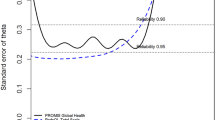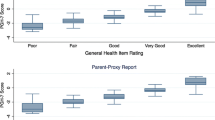Abstract
The measurement of health-related quality of life (HRQOL) in pediatric medicine and health services research has grown significantly over the past decade. The paradigm shift toward patient-reported outcomes (PROs) in clinical trials and population studies has provided the opportunity to emphasize the value and critical need for pediatric patient self-report. In order for HRQOL/PRO outcome comparisons to be meaningful for gender group analyses, it is essential to demonstrate the factorial invariance of an instrument. This study examined factorial invariance of the 23-item PedsQL™ 4.0 Generic Core Scales across gender groups for child self-report ages 5–18. Multigroup Confirmatory Factor Analysis (MGCFA) was performed specifying a five-factor model across gender groups. The analyses were based on 11,356 children recruited from clinic, school, and community populations. Strict factorial invariance across gender groups was demonstrated based on stability of the Comparative Fit Index (CFI) between the models, and indices of practical fit including the Root Mean Squared Error of Approximation (RMSEA), the Non-Normed Fit Index (NNFI), and the Parsimony Normed Fit Index (PNFI). The findings support an equivalent five-factor structure on the PedsQL™ 4.0 Generic Core Scales across gender groups. Based on these data, it can be concluded that boys and girls studied interpreted items on the PedsQL™ 4.0 Generic Core Scales in a similar manner. These findings have implications for studies of gender differences in health outcomes.
Similar content being viewed by others
References
Arrington-Sanders, R., Yi, M. S., Tsevat, J., Wilmott, R. W., Mrus, J. M., & Britto, M. T. (2006). Gender differences in health-related quality of life of adolescents with cystic fibrosis. Health and Quality of Life Outcomes, 4(5), 1–8.
Bentler, P. (1990). Comparative fit indixes in structural models. Psychological Bulletin, 107, 238–246.
Browne, M. W., & Cudeck, R. (1992). Alternative ways of assessing model fit. Sociological Methods and Research, 21, 230–258.
Chen, F. F., Sousa, K. H., & West, S. G. (2005). Testing measurement invariance of second-order factor models. Structural Equation Modeling, 12, 471–492.
Cheung, G., & Rensvold (1999). What constitutes significant differences in evaluating measurement invariance? Conference of the Academy of Management. Chicago
Cheung, G. W., & Rensvold, R. B. (2002). Evaluating goodness-of-fit indexes for testing measurement invariance. Structural Equation Modeling, 9, 233–255.
Connelly, M., & Rapoff, M. A. (2006). Assessing health-related quality of life in children with recurrent headache: Reliability and validity of the PedsQL™ 4.0 in a pediatric sample. Journal of Pediatric Psychology, 31, 698–702.
Eiser, C. (2004). Use of quality of life measures in clinical trials. Ambulatory Pediatrics, 4, 395–399.
FDA (2006). Guidance for industry: Patient-reported outcome measures: Use in medical product development to support labeling claims. Rockville, MD: Center for Drug Evaluation and Research, Food and Drug Administration.
French, B., & Finch, W. (2006). Confirmatory factor analytic procedures for the determination of measurement invariance. Structural Equation Modeling, 13, 378–402.
Gregorich, S. E. (2006). Do self-report instruments allow meaningful comparisons across diverse population groups?: Testing measurement invariance using the confirmatory factor analysis framework. Medical Care, 44, S78–S94.
Greguras, G. J. (2005). Managerial experience and the measurement equivalence of performance ratings. Journal of Business and Psychology, 19, 383–397.
Horn, J. L., & McArdle, J. J. (1992). A practical and theoretical guide to measurement invariance in aging research. Experimental Aging Research, 18, 117–144.
Hu, L., & Bentler, P. M. (1995). Evaluating model fit. In R. H. Hoyle (Ed.), Structural equation modeling: Concepts, issues and applications. Thousand Oaks: Sage.
Hu, L., & Bentler, P. M. (1999). Cutoff criteria for fit indices in covariance structure analysis: Conventional criteria versus new alternatives. Structural Equation Modeling, 6, 1–55.
James, L. R., Mulaik, S. A., & Brett, J. M. (1982). Causal analysis: Models, assumptions, and data. Beverly Hills: Sage.
Joreskog, K. G., & Sorbom, D. (2003). LISREL 8.5. Lincolnwood, IL: Scientific Software International.
Jorngarden, A., Wettergen, L., & von Essen, L. (2006). Measuring health-related quality of life in adolescents and young adults: Swedish normative data for the SF-36 and the HADS, and the influence of age, gender, and method of administration. Health and Quality of Life Outcomes, 4(91), 1–10.
Limbers, C. A., Newman, D. A., & Varni, J. W. (2008). Factorial invariance of child self-report across age subgroups: A confirmatory factor analysis of ages 5 to 16 years utilizing the PedsQL™ 4.0 Generic Core Scales. Value in Health, 11, 659–668.
Little, T. (1997). Mean and covariance structures (MACS) analyses of cross-cultural data: Practical and theoretical issues. Multivariate Behavioral Research, 31, 53–76.
Matza, L. S., Swensen, A. R., Flood, E. M., Secnik, K., & Leidy, N. K. (2004). Assessment of health-related quality of life in children: A review of conceptual, methodological, and regulatory issues. Value in Health, 7, 79–92.
Maydeu-Olivares, A., & D’Zurilla, T. J. (1996). A factor-analytic study of the Social Problem-Solving Inventory: An integration of theory and data. Cognitive Therapy and Research, 20, 115–133.
Meredith, W., & Teresi, J. A. (2006). An essay on measurement and factorial invariance. Medical Care, 44, S69–S77.
Mulaik, S., James, L., Van Alstine, J., Bennett, N., Lind, S., & Stilwell, C. (1989). Evaluation of goodness-of-fit indices for structural equation models. Psychological Bulletin, 105, 430–445.
Olson, L. M., Lara, M., & Frintner, M. P. (2004). Measuring health status and quality of life for US children: Relationship to race, ethnicity, and income status. Ambulatory Pediatrics, 4, 377–386.
Patrick, D. L., & Deyo, R. A. (1989). Generic and disease-specific measures in assessing health status and quality of life. Medical Care, 27, S217–S233.
Razzouk, B. I., Hord, J. D., Hockenberry, M., Hinds, P. S., Feusner, J., Williams, D., & Rackoff, W. R. (2006). Double-blind, placebo-controlled study of quality of life, hematologic end points, and safety of weekly epoetin alfa in children with cancer receiving myelosuppressive chemotherapy. Journal of Clinical Oncology, 24, 3583–3589.
Reinfjell, T., Diseth, T. H., Veenstra, M., & Vikan, A. (2006). Measuring health-related quality of life in young adolescents: Reliability and validity in the Norwegian version of the Pediatric Quality of Life Inventory™ 4.0 (PedsQL™) Generic Core Scales. Health and Quality of Life Outcomes, 4(61), 1–9.
Schwimmer, J. B., Middleton, M. S., Deutsch, R., & Lavine, J. E. (2005). A phase 2 trial of metformin as a treatment for non-diabetic pediatric non-alcoholic steatohepatitis. Alimentary Pharmacology & Therapeutics, 21, 871–879.
Seid, M., Varni, J. W., Cummings, L., & Schonlau, M. (2006). The impact of realized access to care on health-related quality of life: A two-year prospective cohort study of children in the California State Children’s Health Insurance Program. Journal of Pediatrics, 149, 354–361.
Steiger, J. H. (1990). Structural model evaluation and modification: An interval estimation approach. Multivariate Behavioral Research, 25, 173–180.
Sweeting, H. (1995). Reversals of fortune?: Sex differences in health in childhood and adolescence. Social Science and Medicine, 40, 77–90.
Tucker, L. R., & Lewis, C. (1973). A reliability coefficient for maximum likelihood factor analysis. Psychometrika, 38, 1–10.
Upton, P., Eiser, C., Cheung, I., Hutchings, H. A., Jenney, M., Maddocks, A., Russell, I. T., & Williams, J. G. (2005). Measurement properties of the UK-English version of the Pediatric Quality of Life Inventory™ 4.0 (PedsQL™) Generic Core Scales. Health and Quality of Life Outcomes, 3(22), 1–7.
Vaez, M., & Laflamme, L. (2003). Health behaviors, self-rated health, and quality of life: A study among first-year Swedish university students. Journal of American College Health, 51, 156–162.
Vandenberg, R., & Lance, C. (2000). A review and synthesis of the measurement invariance literature: Suggestions, practices, and recommendations for organizational research. Organizational Research Methods, 3, 4–70.
Varni, J. W., Burwinkle, T. M., Berrin, S. J., Sherman, S. A., Artavia, K., Malcarne, V. L., & Chambers, H. G. (2006a). The PedsQL™ in pediatric cerebral palsy: Reliability, validity, and sensitivity of the Generic Core Scales and Cerebral Palsy Module. Developmental Medicine and Child Neurology, 48, 442–449.
Varni, J. W., Burwinkle, T. M., Jacobs, J. R., Gottschalk, M., Kaufman, F., & Jones, K. L. (2003a). The PedsQL™ in type 1 and type 2 diabetes: Reliability and validity of the Pediatric Quality of Life Inventory™ Generic Core Scales and Type 1 Diabetes Module. Diabetes Care, 26, 631–637.
Varni, J. W., Burwinkle, T. M., Katz, E. R., Meeske, K., & Dickinson, P. (2002b). The PedsQL™ in pediatric cancer: Reliability and validity of the Pediatric Quality of Life Inventory™ Generic Core Scales, Multidimensional Fatigue Scale, and Cancer Module. Cancer, 94, 2090–2106.
Varni, J. W., Burwinkle, T. M., & Lane, M. M. (2005). Health-related quality of life measurement in pediatric clinical practice: An appraisal and precept for future research and application. Health and Quality of Life Outcomes, 3(34), 1–9.
Varni, J. W., Burwinkle, T. M., Rapoff, M. A., Kamps, J. L., & Olson, N. (2004). The PedsQL™ in pediatric asthma: Reliability and validity of the Pediatric Quality of Life Inventory™ Generic Core Scales and Asthma Module. Journal of Behavioral Medicine, 27, 297–318.
Varni, J. W., Burwinkle, T. M., & Seid, M. (2006b). The PedsQL™ 4.0 as a school population health measure: Feasibility, reliability, and validity. Quality of Life Research, 15, 203–215.
Varni, J. W., Burwinkle, T. M., Seid, M., & Skarr, D. (2003b). The PedsQL™ 4.0 as a pediatric population health measure: Feasibility, reliability, and validity. Ambulatory Pediatrics, 3, 329–341.
Varni, J. W., Limbers, C. A., & Burwinkle, T. M. (2007a). How young can children reliably and validly self-report their health-related quality of life?: An analysis of 8,591 children across age subgroups with the PedsQL™ 4.0 Generic Core Scales. Health and Quality of Life Outcomes, 5(1), 1–13.
Varni, J. W., Limbers, C. A., & Burwinkle, T. M. (2007b). Parent proxy-report of their children’s health-related quality of life: An analysis of 13,878 parents’ reliability and validity across age subgroups using the PedsQL™ 4.0 Generic Core Scales. Health and Quality of Life Outcomes, 5(2), 1–10.
Varni, J. W., Seid, M., Knight, T. S., Burwinkle, T. M., Brown, J., & Szer, I. S. (2002a). The PedsQL™ in pediatric rheumatology: Reliability, validity, and responsiveness of the Pediatric Quality of Life Inventory™ Generic Core Scales and Rheumatology Module. Arthritis and Rheumatism, 46, 714–725.
Varni, J. W., Seid, M., & Kurtin, P. S. (2001). PedsQL™ 4.0: Reliability and validity of the Pediatric Quality of Life Inventory™ Version 4.0 Generic Core Scales in healthy and patient populations. Medical Care, 39, 800–812.
Varni, J. W., Seid, M., & Rode, C. A. (1999). The PedsQL™: Measurement model for the Pediatric Quality of Life Inventory. Medical Care, 37, 126–139.
World Health Organization (1948). Constitution of the World Health Organization: Basic document. Geneva, Switzerland: World Health Organization.
Yao, G., & Wu, C.-h. (2005). Factorial invariance of the WHOQOL-BREF among disease groups. Quality of Life Research, 14, 1881–1888.
Author information
Authors and Affiliations
Corresponding author
Additional information
The PedsQL™ is available at http://www.pedsql.org.
Rights and permissions
About this article
Cite this article
Varni, J.W., Limbers, C.A. & Newman, D.A. Factorial Invariance of the PedsQL™ 4.0 Generic Core Scales Child Self-Report Across Gender: A Multigroup Confirmatory Factor Analysis with 11,356 Children Ages 5 to 18. Applied Research Quality Life 3, 137–148 (2008). https://doi.org/10.1007/s11482-008-9051-9
Received:
Accepted:
Published:
Issue Date:
DOI: https://doi.org/10.1007/s11482-008-9051-9




